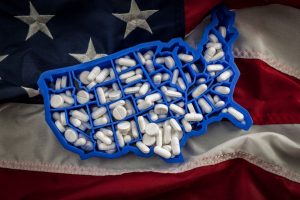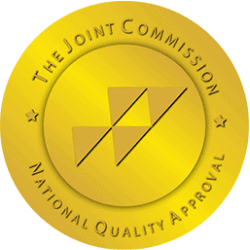Fentanyl Addiction Treatment in Florida
Fentanyl addiction has rapidly become a concerning epidemic in the United States, and Florida is no exception.
With its potent and highly addictive properties, this synthetic opioid has taken hold of many lives throughout the state. However, there is hope for those struggling with fentanyl addiction in Florida.
We provide fentanyl addiction treatment options for those seeking recovery. Our South Florida Behavioral Health Center can help you and your family find healing.
Fentanyl is a synthetic opioid that is 50 to 100 times more potent than morphine and has been responsible for a large portion of the deaths in the ongoing opioid epidemic. This powerful drug is often prescribed for severe pain management, such as chronic cancer pain or during major surgeries. However, it is also being illegally manufactured and sold on the streets.
The opioid epidemic has been declared a national public health emergency, as it continues to claim the lives of thousands of people every year. In the United States alone, there were over 47,000 overdose deaths involving opioids in 2017. Of those deaths, around 28,000 involved synthetic opioids like fentanyl. This represents a significant increase from just a few years earlier when fentanyl was involved in only 3,000 overdose deaths in 2013.
One of the most concerning aspects of fentanyl misuse is its ability to cause fatal overdoses even with small doses. The potency of this drug makes it extremely dangerous and can easily lead to accidental overdoses. It has also been increasingly mixed with other drugs such as heroin or cocaine, making it even more lethal.
The rise in fentanyl-related overdoses highlights the urgent need for effective solutions to combat the opioid epidemic. This includes increased access to addiction treatment programs, better regulation of prescription opioids, and improved education on safe medication use.
Fentanyl is one of the deadliest opioids currently being abused and its impact on individuals and communities cannot be overstated. We need to continue raising awareness about this deadly drug and help individuals struggling to receive help from our opioid treatment program in Florida.
How Does Fentanyl Work?
 Like heroin, morphine, and other opioid drugs, fentanyl works by binding to opioid receptors in the brain that control pain and emotions. When fentanyl binds to these opioid receptors, dopamine levels are increased in the reward areas of the brain, creating feelings of euphoria and relaxation.
Like heroin, morphine, and other opioid drugs, fentanyl works by binding to opioid receptors in the brain that control pain and emotions. When fentanyl binds to these opioid receptors, dopamine levels are increased in the reward areas of the brain, creating feelings of euphoria and relaxation.
However, fentanyl quickly creates a tolerance, requiring more of the drug to create that euphoric feeling. Once in the user’s system, the negative effects are complicated to stop, leading to:
- Cravings – Fentanyl-addicted individuals are afflicted with both psychological and physiological dependence. Finding it hard to concentrate on anything but the drug, they may not be able to eat, sleep, or perform daily activities unless high.
- A compulsion to use – Over time, users develop a physical need that compels them to give into their compulsions and use fentanyl, despite all the havoc the drug wreaks on their lives. Stopping becomes impossible, despite a strong desire to get clean and sober.
- Loss of control – Addicts use more and more each day. Their tolerance builds to the point where they are no longer even chasing the euphoria, but instead using it to avoid withdrawal symptoms.
- Sublimaze
- Actiq
- Durogesic
- Fentora
- Haldid
- Abstral
- Apache
- China Girl
- China White
- Dance Fever
- Goodfella
- Jackpot
- Murder 8
- TNT
- Tango
- Cash
- Powder
- Blotter Paper
- Mixed With Heroin, Cocaine & Tablets
- Snorted
- Smoked
- Orally by pill
- Injected With Needles
- Placed On Skin With A Patch
Ambrosia addiction treatment and mental health programs can help you or a loved one achieve long-term sobriety.
Effects of Fentanyl Abuse
Signs and symptoms of using fentanyl include medically or illicitly, including:
- Dizziness and lightheadedness
- Dry mouth
- Retention of urine
- Suppression of breathing
- Severe constipation
- Itching or hives
- Nausea and vomiting
- Loss of appetite and weight loss
- Headache
- Difficulty seeing
- Hallucinations
- Shaking
- Overdose
Addiction happens over time. The full physical dependence on a drug requires repeated drug abuse, which results in deteriorating health, including:
- Collapsed veins
- Abscesses (swollen tissue with pus)
- Infection of the lining & valves of the heart
- Respiratory depression
- Constipation & stomach cramps
- Liver or kidney disease
- Pneumonia
- Death

Fentanyl Addiction Statistics
 Fentanyl abuse is a growing problem worldwide, with the United States being one of the most affected countries. According to the National Institute on Drug Abuse (NIDA), an estimated 130 Americans die every day from an opioid overdose, and fentanyl is now the leading cause of opioid-related deaths.
Fentanyl abuse is a growing problem worldwide, with the United States being one of the most affected countries. According to the National Institute on Drug Abuse (NIDA), an estimated 130 Americans die every day from an opioid overdose, and fentanyl is now the leading cause of opioid-related deaths.
In 2018, there were approximately 31,335 overdose deaths involving synthetic opioid drugs like fentanyl in the United States. This number has continued to rise since then, with 2020 seeing a significant increase in fentanyl-related deaths due to the COVID-19 pandemic exacerbating existing drug use issues.
Florida is among the states with the highest rate of fentanyl-related deaths. In 2019, there were 2,348 reported deaths involving synthetic opioid drugs in Florida, with fentanyl being responsible for a majority of these deaths. This was a 35% increase from the previous year and highlights the severity of the issue in Florida.
The state has also seen an increase in the availability and potency of fentanyl. Law enforcement agencies have reported seizing larger quantities of fentanyl each year, indicating its widespread use and distribution within Florida’s borders.
In addition to overdose deaths, there are other alarming statistics related to fentanyl addiction in Florida. The state’s Division of Emergency Management reported that between January and June 2020, there were over 1,000 suspected opioid overdoses treated by emergency medical services (EMS) agencies. This number was significantly higher than in previous years and reflects how prevalent fentanyl use has become in Florida.
Fentanyl abuse statistics show that this is a widespread problem that continues to affect individuals across all demographics. In particular, Florida has seen a sharp increase in fentanyl-related deaths and overdoses, emphasizing the need for effective fentanyl addiction treatment measures in the state. Our South Florida detox center can help individuals struggling with dependence on synthetic opioids.
Fentanyl Overdose
The symptoms of fentanyl overdose may include:
- Difficulty breathing or shallow breathing
- Extreme drowsiness or loss of consciousness
- Pinpoint pupils
- Cold and clammy skin
- Blue lips and fingertips
- Slow or weak pulse
- Muscle weakness or limpness
- Seizures or convulsions
If you notice these symptoms in someone who has taken fentanyl, it is crucial to seek immediate medical attention. South Florida out
How to Help
- Call for emergency medical assistance: If you suspect someone has overdosed on fentanyl, call 911 immediately.
- Monitor their breathing: While waiting for help to arrive, monitor the person’s breathing and keep them from lying down on their back, making it harder for them to breathe.
- Give naloxone if available: Naloxone (also known as Narcan) is an overdose reversal medication that can temporarily reverse the binding of fentanyl to opioid receptors.
- Stay with the person: It is essential to stay with the person until medical help arrives and provide reassurance and support.
- Do not leave them alone: If possible, do not leave the person alone while waiting for help as they could lose consciousness or stop breathing suddenly.
Remember, prompt medical attention is crucial in case of fentanyl overdose, so do not wait for symptoms to worsen before seeking help. Our drug and alcohol intervention services can help prevent a fentanyl overdose.

Signs of Fentanyl Addiction
 Some signs of fentanyl addiction may include:
Some signs of fentanyl addiction may include:
- Increased Tolerance: Over time, a person may need larger doses of fentanyl to achieve the same effects, as their body becomes more accustomed to the drug.
- Withdrawal Symptoms: When a person stops taking fentanyl or reduces their dosage, they may experience physical and psychological withdrawal symptoms such as nausea, vomiting, diarrhea, headache, sweating, anxiety, and irritability.
- Using Fentanyl Despite Negative Consequences: A person with a fentanyl addiction will continue to use the drug even though it has caused negative consequences in their life such as relationship problems, financial difficulties, or legal issues.
- Inability to Control Use: People who are addicted to fentanyl often find it difficult to control how much they use or how often they use it. They may try to cut back on their usage but find themselves unable to do so.
- Neglecting Responsibilities: As addiction takes hold, a person may begin neglecting important responsibilities such as work, school, or family obligations in favor of using fentanyl.
- Changes in Behavior: Addiction can cause changes in behavior such as secretive or suspicious behavior, mood swings, and isolation from friends and family.
- Financial Problems: The cost of supporting a fentanyl addiction can lead to financial strain and problems for an individual.
- Physical Health Issues: Prolonged use of fentanyl can lead to physical health problems such as respiratory depression, heart problems, and liver damage.
- Cravings and Obsession with Fentanyl: A person with a fentanyl addiction may constantly think about obtaining and using the drug.
If you or someone you know is displaying these signs and symptoms of fentanyl abuse, seek help from our inpatient rehab in West Palm Beach for proper drug addiction treatment and support.
Risk Factors for Fentanyl Misuse
- Pre-existing Substance Abuse: Individuals who have a history of drug addiction, particularly with opioids, are at a higher risk of abusing fentanyl.
- Prescription Opioid Use: Those who have been prescribed opioids, such as oxycodone or hydrocodone, may develop a tolerance to the medication and turn to fentanyl for a stronger high.
- Mental Health Disorders: People with mental health issues, such as depression or anxiety, may be more prone to using fentanyl as a form of self-medication.
- Social Environment: Peer pressure and exposure to individuals who use drugs can increase the likelihood of fentanyl abuse.
- Age and Gender: Younger individuals and males tend to have a higher risk of fentanyl abuse.
- Genetics: Some studies suggest that there may be a genetic predisposition for opioid addiction in certain individuals.
- Easy Accessibility: The availability of fentanyl on the illegal market, coupled with its lower cost compared to other opioids, makes it easier for individuals to access and abuse.
- Co-occurring Chronic Pain: People who suffer from chronic pain are often prescribed opioids, which can lead to addiction and ultimately the use of fentanyl.
- Lack of Awareness/Knowledge: Many people are not aware of the potency and dangers associated with fentanyl use, leading them to unknowingly use it.
- Mixing Substances: Combining fentanyl with other substances, such as alcohol or benzodiazepines, can significantly increase the risk of overdose and death.

Why is Fentanyl Dangerous?
One of the main reasons why fentanyl is so dangerous is its potency. A small amount of fentanyl can have a significant impact on the body, making it easy for users to accidentally overdose. The Centers for Disease Control and Prevention (CDC) reports that most fentanyl-related overdoses are caused by unintentional exposure to the drug.
Another reason why fentanyl is dangerous is its potential for addiction. Due to its high potency, individuals who use fentanyl may quickly develop a tolerance and dependence on the drug, leading them to take higher doses to achieve the desired effects. This cycle of increasing the bind to opioid receptors can quickly lead to addiction.
Moreover, fentanyl is often mixed with other drugs, such as heroin or cocaine, without the user’s knowledge. This combination greatly increases the risk of overdose and death since individuals may not be aware of how much fentanyl they are consuming. Additionally, street dealers often cut or mix fentanyl with other drugs to increase their profits. This lack of quality control can result in varying levels of potency in each batch of drugs sold, increasing the risk of overdose for users.
In conclusion, Fentanyl is dangerous due to its high potency, potential for addiction, frequent mixing with other substances, and lack of quality control in illicit drug production. Individuals must understand the risks associated with using this powerful opioid and seek help if they need assistance in overcoming addiction.
Fentanyl Addiction Treatment
Detoxification is the first step in treating fentanyl addiction. During this process, medical professionals will help the individual safely and gradually rid their body of fentanyl. This can help alleviate withdrawal symptoms and begin the process of overcoming physical dependence on the drug.
Inpatient treatment involves staying at a residential facility for some time to receive round-the-clock care and support. In these programs, individuals may participate in therapy sessions, learn coping skills, and receive medical care as they work toward recovery.
Outpatient treatment allows individuals to attend therapy sessions and other treatments while living at home or in a sober living environment. This option provides more flexibility for those who cannot take time away from work or family responsibilities.
Intensive outpatient programs (IOP) offer higher care than traditional outpatient treatment. Individuals attend multiple therapy sessions each week and have access to additional support services such as group counseling and case management.
Our medication-assisted treatment (MAT) programs in Florida involve using medication, such as buprenorphine or methadone, in combination with therapy to treat opioid addiction. These medications help reduce cravings for fentanyl and minimize withdrawal symptoms while individuals work toward recovery.
It is crucial for individuals seeking fentanyl addiction treatment to carefully consider their options and choose the approach that best fits their needs. Treatment may also involve ongoing support through 12-step programs or aftercare programs to maintain sobriety after completing a formal program. With proper treatment and support, recovery from fentanyl addiction is possible.

Fentanyl Addiction Treatment is Available at Ambrosia Behavioral Health
 If you or a loved one is struggling with substance abuse, know that help is available at Ambrosia Behavioral Health in Florida. Our fentanyl addiction treatment center offers personalized programs to help individuals overcome their addiction and achieve long-term recovery.
If you or a loved one is struggling with substance abuse, know that help is available at Ambrosia Behavioral Health in Florida. Our fentanyl addiction treatment center offers personalized programs to help individuals overcome their addiction and achieve long-term recovery.
At Ambrosia, we understand that fentanyl addiction is a complex and challenging disorder. Have your fentanyl addiction treated by a staff that truly cares about you and your well-being. Our team of experienced professionals works closely with each client to develop an individualized treatment plan that addresses their unique needs and concerns.
Our fentanyl addiction treatment program incorporates evidence-based therapies, such as cognitive-behavioral therapy (CBT), dialectical behavior therapy (DBT), and group therapy, to help individuals gain insight into their addiction and develop healthy coping skills. We also offer medication-assisted treatment (MAT) to alleviate withdrawal symptoms and cravings.
In addition to our clinical approach, we also provide holistic therapies like yoga, meditation, art therapy, and equine-assisted therapy to promote physical, mental, and emotional well-being during the recovery process.
Our facility provides a safe and supportive environment for individuals to heal and recover from fentanyl addiction. Our compassionate staff is available 24/7 to provide guidance, support, and encouragement throughout the journey towards sobriety.
Don’t let fentanyl control your life any longer. Contact us today to learn more about our fentanyl addiction treatment program in Florida. You deserve a life free from the grips of addiction – let us help you get there.

Dr. Alam is an internationally renowned psychiatrist with academic affiliations with Northwestern University and University of Illinois, Chicago where he completed his residency training. He has been a principal investigator for over forty studies and has been involved in research leading to the approval of most psychiatric medications currently on the market. He is the founder of the Neuroscience Research Institute which continues to conduct research on cutting edge medication and interventional psychiatry. Dr. Alam is a Distinguished Fellow of the American Psychiatric Association and the American Society of Addiction Medicine. He has won several awards and has been featured extensively on radio and television.








